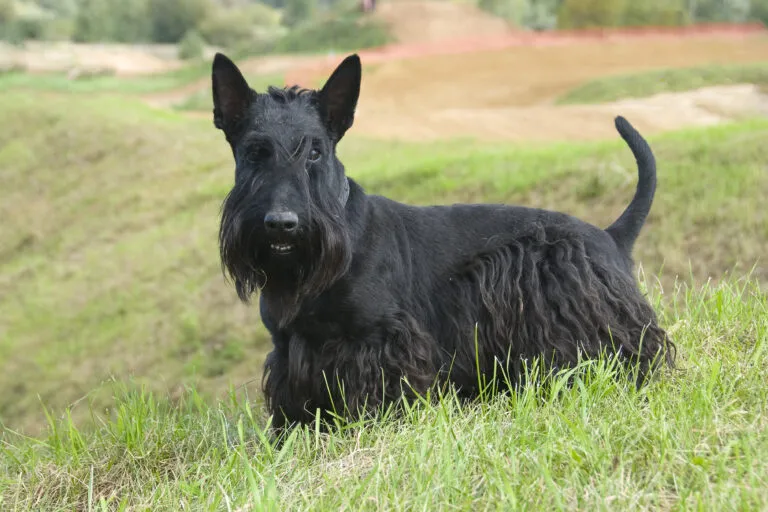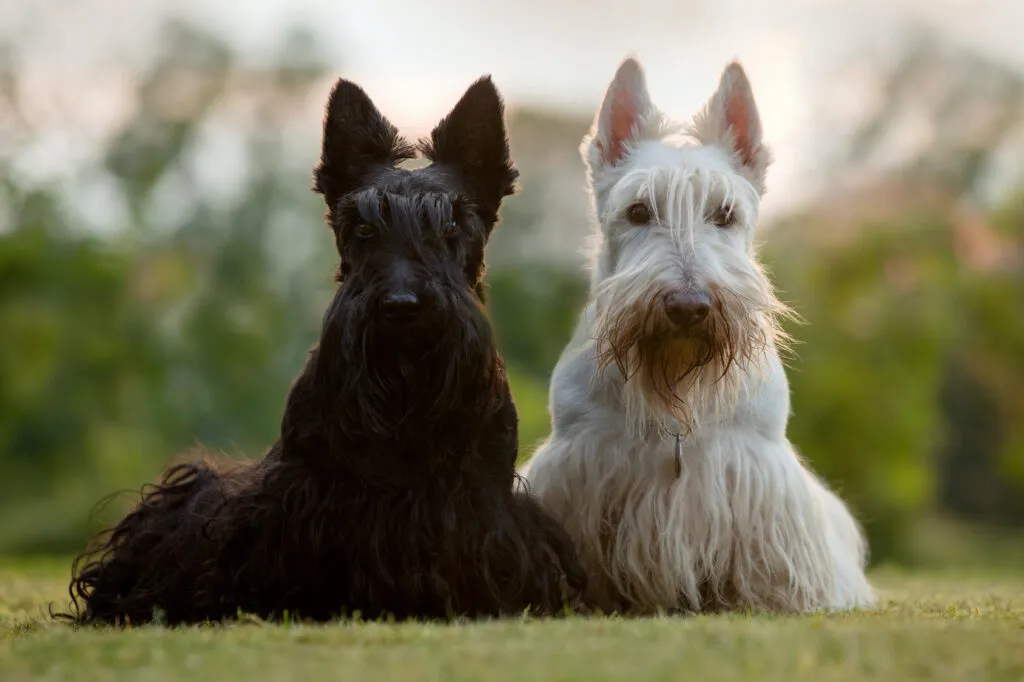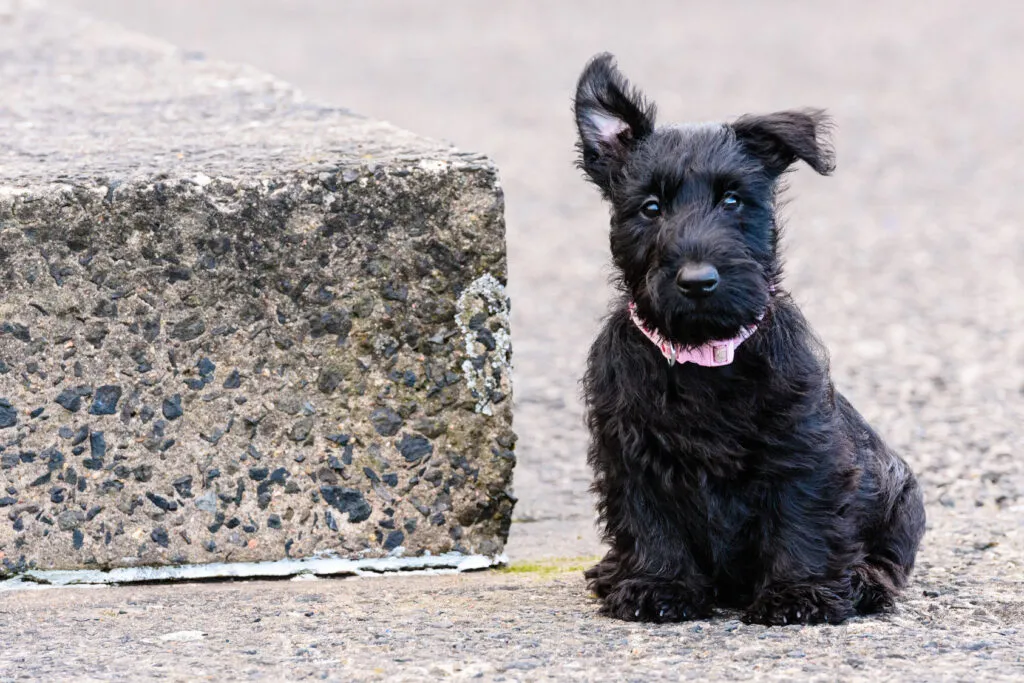Medium Size Poodle
A distinguished beard, large ears, and a compact body on short legs shape the typical silhouette of this small dog from Scotland. The Scottish Terrier's unique look combined with a charming character has quickly increased the number of followers of this breed. Today, the “Scottie”, as its fans lovingly call it, is a popular family and city dog.

© Konstantin / stock.adobe.com
The Scottish Terrier is easily recognized by its wiry black coat, upright tail, and distinctive long head with pointed ears and a bushy beard
A Scottish Terrier with well-groomed fur is easily recognisable at first glance.
The low-legged, around 10kg dog with a shoulder height of up to 28cm stands out due to its distinctive appearance: The pointed ears sit on a relatively long head in proportion to its body, which, combined with the striking beard, gives it a somewhat grumpy expression.
The body is compact and muscular, the rod upright. The short, soft undercoat, in combination with the harsh, wiry top coat, forms a water-repellent fur.
Most Scottish Terriers are black, but there are also brindle and wheaten representatives of the breed.
The Scottish Terrier belongs to the four Scottish terrier breeds, along with the closely related Skye Terrier, West Highland White Terrier, and Cairn Terrier. Despite the old-fashioned impression the Scottie visually makes, the history of this breed only dates back about 150 years.
The ancestors of today’s Scotties likely originated from the area around Perthshire and the Scottish Highlands, but they did not resemble today’s standard much. At that time, their owners valued their hunting skills: The muscular terriers with strong jaws were used for hunting foxes, badgers, and otters and likely had longer legs than today’s Scotties.
The roots of the modern Scottish Terrier can be traced back to the mid-19th century, where it was first bred in Aberdeen. The breed was initially called the “Aberdeen Terrier”. The dogs were first shown at an exhibition in 1879 and quickly gained popularity outside Scotland.
Especially in the 1920s and 30s, the black Scottish Terrier became a popular fashion dog and even made its way to the White House several times: Franklin D. Roosevelt’s family lived with the beloved dog Fala, and the Scottish Terriers Barney and Miss Beazley resided there as “First Dogs” under President George W. Bush in the early 21st century.
Today, while you don’t see many Scottish Terriers on the streets, the breed still enjoys a small but loyal following. Scotties are most commonly found in their official home country, the United Kingdom, and the USA.
A Scottish Terrier is a dignified and balanced dog, always loyal to its loved ones. It appreciates strangers less and maintains distance – this also applies to unknown dogs, although it is generally less quarrelsome in this regard than many other terrier colleagues.
This brave four-legged friend guards its territory but does not tend to bark excessively. The Scottie is not easily disturbed and is one of the more relaxed terriers, though it is always on the move and does not like being alone.
The original hunter can get excited by potential prey: remember that this dog remains a hunter at heart and cannot be let off the lead everywhere.
 © ondrejprosicky / stock.adobe.com
© ondrejprosicky / stock.adobe.com
As often is the case with terriers, consistency is the key to successfully training a Scottie. Be aware, though: even the best-trained Scottish Terrier will not be an obedient dog. If it tests your patience, never apply pressure or use harsh words.
Always motivate your four-legged friend and consistently stick to your rules – this way, even beginners willing to learn can successfully train a Scottish Terrier. The training might take a bit longer due to the nature of this breed, and the terrier personality will always come through. Work with these typical characteristics instead of against them.
It’s helpful to attend puppy playgroups and later visit the dog school with your Scottie. Contact with other four-legged friends as well as early imprinting and socialisation by the breeder can prevent your companion from becoming a loner.
Certain lines are more prone to craniomandibular osteopathy (CMO), a hereditary bone disease of the skull. The risk of this and the, albeit rare, “Scotty Cramp”, a seizure-like movement disorder, can be significantly reduced through responsible breeding.
Older Scotties are more prone to bladder cancer than other breeds. Males tend to have an enlarged prostate, though this often has hardly noticeable effects – affected dogs should be checked regularly. The breed also tends to show elevated liver values in old age, though often without actual liver disease.
These dogs generally have a normal life expectancy. The cause of these elevated values is still uncertain, but an enzyme disorder is suspected. Overall, the Scottish Terrier is a robust breed that.
With sufficient exercise and a healthy diet, it can reach an age of 12 years or more.
Compact Scottish Terriers tend to become overweight, so it’s important to ensure a balanced, high-quality diet that provides everything your pet needs. Choose dog food with plenty of high-quality protein, regardless of whether you feed dry or wet food.
Avoid pet food with cheap fillers like grain, as this may fill the dog up temporarily but often leads to intolerances. When a Scottish Terrier becomes a new household member, give it the familiar food for the first few days. Only once it feels completely at home should you start changing its food. Do this gradually by mixing more of the new dog food with the familiar food each day.
Don’t overdo it with treats: if you want to reward your Scottie with treats, you can use dry food from its regular daily amount. Dental hygiene snacks or dried chew items and occasionally some raw beef are healthy delicacies for your companion and support dental hygiene. Of course, your Scottish Terrier should always have access to enough drinking water.
Like many other breeds, the Scottie’s fur has changed over the decades and is now far more high-maintenance than it was for its hunting ancestors. The dense coat should be regularly, at least every three months, trimmed for shape. Pruning shears are used to remove loose hair from the skin.
This is particularly important because the Scottie does not experience a biannual shedding season – it needs human help to remove old hair. Trimming should initially be done by a professional – preferably a dog groomer who specialises in trimming Scottish Terriers. After observing and getting a feel for the desired result, patient and determined dog owners can try trimming themselves – there are many helpful guides online.
Additionally, your companion should be brushed multiple times a week: firstly, brush the entire dog and then comb through the fur. Tangling, especially under the armpits and hind legs, should be prevented. For your four-legged friend to find grooming relaxing, it helps to practice brushing and combing regularly from puppyhood.
If a bath becomes necessary, use a special dog shampoo and make sure your dog is completely dry before heading back outside, especially in cold weather. By the way: Scottish Terriers do not shed much hair in the house.
Proper dental care is also important for your dog’s wellbeing: some Scottie owners start the dental hygiene routine from puppyhood with special dog toothbrushes and toothpaste to effectively prevent tartar.
The Scottish Terrier enjoys accompanying you on walks but does not have a strong sporting enthusiasm – its short legs would also be a hindrance in the long run. Nonetheless, it loves exploring nature and is not a couch potato.
Sport is still possible if you both enjoy it: size-appropriate agility or jogging with your fully grown Scottie are great options to keep this little beauty, with its many hidden muscles, in shape.
Obedience training can also be a fulfilling activity for some human-Scottie teams. Scotties love toys and games, especially hunting games.
 © Stephen / stock.adobe.com
© Stephen / stock.adobe.com
Before your new companion moves in, make sure everything is ready in its new home. This includes the necessary basic equipment: provide your Scottie with several easy-to-clean bowls for food and water and cosy sleeping spots like dog blankets and dog beds. Your furry friend also needs a collar or harness suitable for its current size, a lead for daily walks, and possibly a drag line for training.
For car rides, make sure to have the proper safety measures – either with transport boxes, dog belts or grids for the boot. Special car blankets can also be a good addition. Your lovely Scottie needs several grooming tools: have a dog brush, comb, special dog shampoo, a tick remover, and nail clippers on hand.
There are many toys available to bring delight to your Scottie at any age! The Scottish Terrier, aside from being a symbol of Scotland along with Highland cows, has inspired numerous charming and witty accessories that captivate Scottie fans: from jewellery or shirts with the typical silhouette to original Scottish shortbread in Scottie shape.
This confident dog suits people who accept and properly manage its stubborn nature. It feels comfortable both in the countryside and the city and can even thrive as a flat dog. The breed is beginner-friendly, though beginners should be willing to seek tips specific to terrier training.
It can be an excellent companion for families or individuals, young and old, but often tends to focus on one person. For children who treat it with respect and allow it retreats, the Scottish Terrier is a dedicated playmate.
However, if you want a consistently good-natured and very cuddly dog with a strong will-to-please, this breed might not be the right choice: only get a terrier if you appreciate its traits. Coexisting with other pets like cats or guinea pigs can only be achieved after thorough introduction. Ideally, the Scottie should meet these species as a young puppy.
The Scottish Terrier also makes a great travel companion, enjoying hiking holidays with you. Many hotels now welcome well-behaved dogs.
For those seeking a Scottie puppy, a reputable breeder is a must. Only here can you be certain of getting a purebred Scottish Terrier. Association membership is a basic requirement for breeding with heart and mind, requiring much more than just any two Scotties.
Extensive knowledge of breed health, type, and character is essential for meaningful breeding goals. Your new companion will be ready to move in at the earliest at eight weeks old. By then, it will typically have a pet passport, complete with a chip, and will be repeatedly dewormed and vaccinated. Don’t forget to keep up with booster vaccinations.
If you’re looking for an older Scottie, you might get lucky with rescues, where Scottish Terriers sometimes need new homes for various reasons. Many countries have organisations specialising in rehoming Scotties in need. A quick internet search will help you find these.
We wish you many wonderful adventures with your Scottie!
If you’re enchanted by the Scottish Terrier, you might also like these terriers:
Fans of the Bearded Collie agree that those who aren't familiar with this dog breed simply have to get acquainted with it. And those who have experienced how a Bearded Collie bolts across meadows with its flowing fur, how it rolls around full of energy and joy and how it attentively and observantly takes into account its owners wishes become simply addicted to this original dog breed and its unique charm.
The Goldendoodle isn't a breed, but a pairing between Golden Retrievers and Medium or Standard Poodles. Marketed as a low-maintenance dog for allergy sufferers, this hybrid is enjoying increasing popularity amongst dog lovers, similar to the Labradoodle.